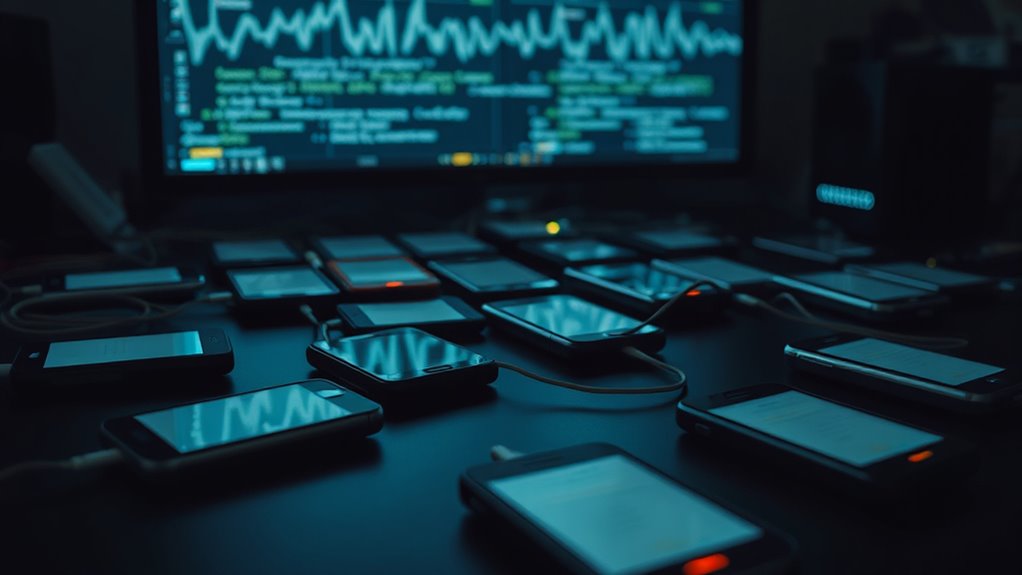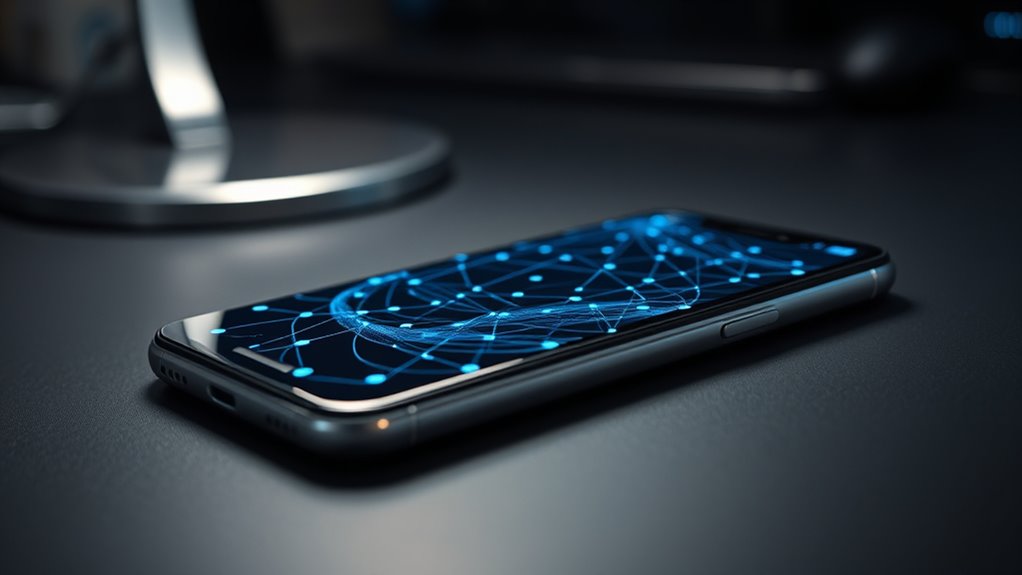Cybersecurity experts warn that ghost data can still be on your old phones even after you delete everything. This residual information includes personal details, messages, and app remnants that aren’t fully removed through normal wipes or resets. If you don’t properly secure or sanitize your device, hackers or malicious apps could access this hidden data. To protect yourself from these risks, it’s important to learn how to properly dispose of old phones—that’s just the start of what you’ll discover next.
Key Takeaways
- Residual data from old phones can include personal info and app remnants, often recoverable after deletion.
- Ghost data remains hidden behind encryption and backups, making complete removal challenging.
- Factory resets rarely eliminate all traces, leaving vulnerabilities accessible to hackers or malicious apps.
- Proper data disposal—including encryption, overwriting, and physical destruction—reduces security risks.
- Ignoring ghost data can lead to privacy breaches, identity theft, and future security vulnerabilities.
Understanding the Nature of Ghost Data

Ghost data refers to residual information stored on old phones that can persist even after you’ve deleted or overwritten files. This hidden data often remains intact due to how data encryption works; even if you delete a file, fragments may still exist in encrypted form. Additionally, cloud backup services can inadvertently store copies of your data, leaving traces on servers that are difficult to fully erase. These backups may include sensitive information, apps, or settings, making it easier for cybercriminals to access your details if your device falls into the wrong hands. Understanding that ghost data isn’t just deleted but often hidden behind layers of encryption and backups highlights why old devices can still harbor potential security risks. It is also important to recognize how data remnants can be recovered through specialized tools, emphasizing the need for thorough data sanitization before disposal. This underscores the importance of using secure data erasure methods to ensure your information cannot be recovered after wiping your device. Properly managing device disposal processes can significantly reduce the risk of data recovery and protect your privacy. Always consider how your data is stored, encrypted, and backed up before discarding an old phone.
How Old Devices Harbor Hidden Information

Old devices often hold hidden information because remnants of deleted files and data fragments can remain accessible long after you think you’ve erased everything. This is due to the way data recovery works; when you delete files, the device typically marks the space as available rather than permanently removing the data. Skilled attackers or data recovery tools can retrieve this leftover information, exposing sensitive details. If you’re not careful, these hidden data remnants can lead to privacy breaches, revealing personal photos, messages, or passwords. Even a factory reset doesn’t always wipe all traces clean, leaving behind ghost data that can be accessed with specialized software. To truly protect your privacy, you need to securely erase your old device’s data or consider professional data destruction methods. Understanding data erasure techniques can also help in safeguarding your digital assets from potential cyber threats, especially since improper deletion can leave behind residual data that is vulnerable to recovery. Additionally, awareness of data recovery methods can empower users to take more effective steps in protecting their information.
Risks Posed by Lingering Data to Users

Lingering data on your devices can pose serious risks, even if you think you’ve erased everything. Data retention means some information may still be stored secretly, making it accessible to hackers or malicious apps. This residual data can include personal details, passwords, or sensitive messages, leaving you vulnerable to privacy risks. If old phones aren’t properly wiped, attackers can recover this information through simple data recovery tools. Additionally, third parties, like app developers or cloud services, might retain copies of your data longer than you realize, increasing exposure. This lingering data can be exploited in identity theft, fraud, or targeted scams. Understanding the risks involved with data retention emphasizes the importance of thorough data management to protect your privacy and prevent unauthorized access. Furthermore, astrology and attractiveness can influence perceptions of personal data security, as individuals may not be aware of how their traits are analyzed or exploited in digital environments. Proper data disposal practices, such as overwriting or physical destruction, are crucial to prevent data recovery and safeguard sensitive information. Implementing secure deletion methods can significantly reduce the likelihood of recovery and protect your digital footprint. A comprehensive understanding of data security practices is vital to minimize these risks and safeguard your digital footprint.
Methods to Properly Secure and Erase Smartphones

To guarantee your smartphone’s data is fully protected, you need to use effective methods to securely erase all information before selling or recycling it. Start by backing up important data, then perform a factory reset to wipe personal files. Follow up by encrypting your data—most devices offer built-in options—to ensure that even if some remnants remain, they’re unreadable. Additionally, keep your device’s firmware updated; manufacturers release security patches that fix vulnerabilities, making it harder for ghost data to persist. Before disposal, consider overwriting storage or using specialized software to securely erase data. These steps help prevent unauthorized access and ensure your personal information doesn’t linger, giving you peace of mind that your old phone no longer poses a security risk. Regularly maintaining your device and practicing good security habits further reduce the chances of ghost data haunting your devices. Being aware of dog names, such as those inspired by Irish heritage or pop culture, can also help keep your mind sharp and attentive to important details. Incorporating Glycolic Acid benefits into your skincare routine can enhance skin renewal and protect against signs of aging, supporting overall skin health. Additionally, understanding how arcade machines function can inform better security practices for modern digital devices.
Recommendations for Safe Disposal and Data Sanitization

Ensuring your device is securely disposed of requires following specific data sanitization practices. First, before recycling or selling your phone, perform a factory reset to remove personal data. Second, disable cloud backups and delete any stored backups to prevent residual data from lingering. Third, use data encryption tools to securely overwrite remaining files, making recovery impossible. If possible, employ specialized software designed for data sanitization that overwrites storage multiple times. Remember, cloud backups may still contain your data, so ensure they are deleted from service providers. Proper disposal also involves physically destroying the device if sensitive information was stored. Additionally, understanding vape juice expiration and proper storage methods can prevent unintentional data or information loss related to device use. Employing data sanitization techniques and understanding Gold IRA options can ensure that residual data cannot be recovered by malicious actors. Implementing privacy protection measures during disposal significantly reduces the risk of ghost data haunting your old phones and safeguards your privacy effectively.
Frequently Asked Questions
Can Ghost Data Be Used to Hack Current Devices?
Ghost data can potentially be used to hack your current devices. If malware infiltrates old phones through data recovery or hidden files, it might be transferred to newer devices, posing security risks. These malicious files can remain dormant but activate later, enabling unauthorized access or data theft. To protect yourself, regularly update your software, avoid suspicious files, and perform thorough malware scans to prevent ghost data from compromising your devices.
How Often Should Users Erase Their Old Phones?
You should erase your old phones regularly, especially if you’re planning to sell or give them away. Before doing a factory reset, guarantee all your data is backed up and use data encryption if available. Erasing your device often minimizes the risk of ghost data being exploited by hackers, as it removes residual information that could be used maliciously. Doing this periodically helps keep your personal information secure.
Are There Specific Brands More Vulnerable to Ghost Data?
You might wonder if certain brands are more vulnerable to ghost data. While phone manufacturers generally aim for security, some brands may have specific vulnerabilities due to outdated software or weaker encryption. It’s wise to research brand vulnerabilities before purchasing, and always keep your device updated. Regularly erasing old phones also minimizes ghost data risks, regardless of the manufacturer, helping protect your personal information from lingering digital remnants.
What Tools Are Most Effective for Deep Data Cleaning?
Imagine you’re a detective in the digital age, unraveling ghost data. You need effective tools to clean your phone’s deep data. Use data encryption to secure sensitive info and cloud backups to make sure no data is left behind. To fully eliminate ghost data, consider specialized cleaning apps that thoroughly wipe storage. Combining these tools guarantees your old phone’s data is thoroughly cleaned, protecting your privacy like a true cyber sleuth.
Is Ghost Data Detectable Without Specialized Software?
You can sometimes detect ghost data without specialized software by thoroughly reviewing your phone’s storage and deleting unused apps and files. However, hidden or residual data linked to data recovery efforts or privacy breaches can be elusive. While manual checks help, specialized tools are often necessary to identify deeply embedded ghost data, ensuring your device’s security and privacy. Without them, some traces of ghost data may remain undetected.
Conclusion
Remember, old phones are like abandoned houses filled with ghost data—echoes of your past that can come back to haunt you. By properly cleaning and disposing of your devices, you’re not just deleting files; you’re sealing the doors to hidden dangers. Safeguarding your digital world means respecting the ghosts of your data, ensuring they don’t linger to threaten your privacy. Take control now—clear the past to protect your future.









